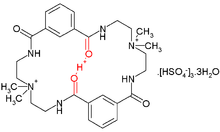Low-Barrier Hydrogen Bond

A Low-Barrier Hydrogen Bond ( LBHB , German: hydrogen bridge bond with low energy barrier ) is a special type of hydrogen bond . LBHB can occur when the p K a value of the two heteroatoms exactly matches, which allows the hydrogen atom between them to be used more evenly. This hydrogen exchange leads to the formation of particularly short, strong hydrogen bonds.
properties

Standard hydrogen bonds are longer and the proton clearly belongs to one of the heteroatoms. If the p K a value of the heteroatoms is exactly the same, an LBHB at a shorter distance (≈ 2.55 Å) is possible. When the distance further decreases (<2.29 Å), the bond as is single-well - or short-strong hydrogen bond characterized.
Proteins
Low-barrier hydrogen bonds occur in hydrophobic environments of proteins. Several amino acid residues work together in a charge transfer system (also called a proton relay) to control the p K a values of the residues involved. LBHB also occur on the surface of proteins, but are unstable due to their proximity to water and the conflicting requirements of strong salt bridges at protein-protein interfaces.
Enzyme catalysis
It has been suggested that low-barrier hydrogen bonds are relevant to enzyme catalysis in two circumstances. First, in a charge transfer system, an LBHB could activate a catalytic moiety within an active site (e.g., between an acid and base within a catalytic triad ). Second, the formation of an LBHB could form during catalysis to stabilize a transition state (e.g., with a substrate transition state in an oxyanion hole ). These two mechanisms are controversial, with theoretical and experimental evidence conflicting as to whether they occur at all.
Since the 2000s, there has been a general consensus that LBHB are not used by enzymes to aid catalysis. However, it was suggested in 2012 that LBHB is involved in the binding of phosphates to arsenates in the phosphate transport system (despite an arsenate-rich environment). This finding could indicate the possibility that, in very rare cases, LBHB may play a catalytic role in the selection of ion size.
Individual evidence
- ^ Donald Voet, Judith G. Voet, Charlotte W. Pratt: Textbook of Biochemistry . 3. Edition. John Wiley & Sons, Weinheim 2019, ISBN 978-3-527-34286-0 , pp. 427 .
- ^ G. Gilli, P. Gilli: Towards an unified hydrogen-bond theory . In: Journal of Molecular Structure . tape 552 , no. 1 , September 26, 2000, pp. 1-15 , doi : 10.1016 / S0022-2860 (00) 00454-3 .
- ↑ Victor W. Day, Md. Alamgir Hossain, Sung Ok Kang, Douglas Powell, Gerald Lushington, Kristin Bowman-James: Encircled Proton. In: Journal of the American Chemical Society. Volume 129, No. 28, 2007, p. 8692, doi: 10.1021 / ja0724745 .
- ↑ B. Schiøtt, BB Iversen, GK Madsen, FK Larsen, TC Bruice: On the electronic nature of low-barrier hydrogen bonds in enzymatic reactions. In: Proceedings of the National Academy of Sciences . Volume 95, number 22, October 1998, pp. 12799-12802, doi: 10.1073 / pnas.95.22.12799 , PMID 9788994 , PMC 23598 (free full text).
- ↑ a b H. Ishikita, K. Saito: proton transfer reactions and hydrogen-bond networks in protein environments. In: Journal of the Royal Society, Interface. Volume 11, No. 91, February 2014, p. 20130518, doi: 10.1098 / rsif.2013.0518 , PMID 24284891 , PMC 3869154 (free full text) (review).
- ^ WW Cleland, PA Frey, JA Gerlt: The low barrier hydrogen bond in enzymatic catalysis. In: Journal of Biological Chemistry . Volume 273, No. 40, October 1998, pp. 25529-25532, doi: 10.1074 / jbc.273.40.25529 , PMID 9748211 (review).
- ↑ EL Ash, JL Sudmeier, EC De Fabo, WW Bachovchin: A low-barrier hydrogen bond in the catalytic triad of serine proteases? Theory versus experiment. In: Science . Volume 278, No. 5340, November 1997, pp. 1128-1132, doi: 10.1126 / science.278.5340.1128 , PMID 9353195 .
- ^ A b C. N. Schutz, A. Warshel: The low barrier hydrogen bond (LBHB) proposal revisited: the case of the Asp. His pair in serine proteases. In: Proteins. Volume 55, No. 3, May 2004, pp. 711-723, doi: 10.1002 / prot.20096 , PMID 15103633 .
- ^ A. Warshel, PK Sharma, M. Kato, Y. Xiang, H. Liu, MH Olsson: Electrostatic basis for enzyme catalysis. In: Chemical Reviews . Volume 106, No. 8, August 2006, pp. 3210-3235, doi: 10.1021 / cr0503106 , PMID 16895325 (review).
- ↑ M. Elias, A. Wellner, K. Goldin-Azulay, E. Chabriere, JA Vorholt, TJ Erb, DS Tawfik: The molecular basis of phosphate discrimination in arsenate-rich environments. In: Nature . Volume 491, No. 7422, November 2012, pp. 134-137, doi: 10.1038 / nature11517 , PMID 23034649 .